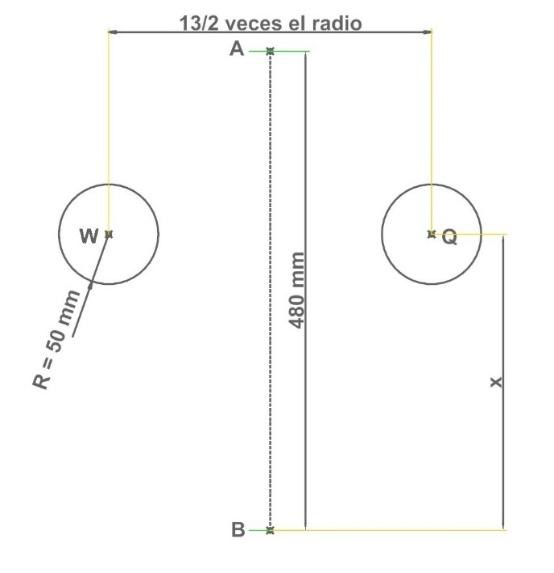Written by Jesús Alonso Trigueros. Dr. Civil Engineer and Professor at the Universidad Politécnica de Madrid.
The master guitar maker José Ramírez Martínez (1922 – 1995), known as José Ramírez III, created a guitar model based on golden ratios and magic numbers endowed with a special symbology, configuring a differentiating geometry that achieved a unique sonority.
The golden ratio on the Ramírez guitar
The model is based on the longest length of the body of the guitar and the radius of the circumferences of the concavities in its waist, which makes it possible to define an outline based on tangencies between circumferences, straight lines and arcs.
The golden ratio in the Ramírez III guitar is in its entire design phase; and not only that, but it uses some harmonic numerical series. With the golden ratio and the magic of some numbers applied to the measurements of his guitar, he achieved a greater perception of beauty, not only in the form, but also in the frequency of vibration of his strings and in the transmission of sounds.
The influence of Le Corbusier
José Ramírez III follows in the footsteps of the great artists of antiquity and, without doubt, is also familiar with one of the great geniuses of modern art, the painter and architect Le Corbusier, who in the 1950s made known his contribution to the research that Vitruvius, Da Vinci and Leon Battista Alberti had begun in an effort to find the mathematical relationship between the measurements of man and nature.
For Le Corbusier, measurements start from the measurement of man with his hand raised (226 cm) and its half, the height of the navel (113 cm). From the first measure, multiplying successively and dividing in the same way by the golden number (1.618), the so-called blue series is obtained, and from the second, in the same way, the red series. Each one being a Fibonacci sequence and allowing thousands of harmonic combinations.
Blue series, in metres: …, 9.57; 5.92; 3.66; 2.26; 1.40; 0.86; 0.53; 0.33; 0.20; …
Red series, in metres: …, 4.79; 2.96; 1.83; 1.13; 0.70; 0.43; 0.26; 0.16; 0.10; …
The measurements of the Ramírez guitar
In the Ramírez III guitar, the longest length of the body of the guitar is 480 mm (4.8 dm) – note the relationship with the first number of Le Corbusier’s red series -. On the other hand, the quotient between the greatest length of the body of the guitar (AB = 480 mm) and the radius of the concavity circumferences at its waist (50 mm) is 9.6 – rounding of the number of the first term of the blue series above -.
José Ramírez III creates the body of his guitar with only two data: the largest magnitude and the radius of the circumferences corresponding to the concavity of his waist (see figure 1).
Figure 1. Drawing of the body of the Ramírez III guitar, from the radius of the circumferences corresponding to the concavity of its waist.
Everything else is a consequence of golden ratios, proportions and numerical relations (see figure 2).
Figure 2. Drawing of the Ramírez III guitar from golden ratios, proportions and numerical relations.
Thus, it follows that:
The longest length of the guitar body is AB = 480 mm and coincides with its axis of symmetry.
The two circles, C1 and C2, corresponding to the concavities, have a radius of 50 mm and their centres are 6.5 (13/2) times their radius; moreover, these centres are located at a distance x from the lowest point of the guitar, which is known to be the proportional average between “AB” and “(AB – x)”.
Maestro Ramírez III wanted to leave a record of the number 13 on his guitar, but without showing it explicitly to indicate that the guitar is a path, an evolution towards a state of greater understanding or personal growth.
The graphic construction to obtain the golden segment of the diameter of the concavity circle allows three reference points J, K and L to be obtained: the first two by intersection of the line that joins the V end of the diameter with the centre of the circle of the same diameter tangent at the other end, and the third as the end of the golden segment. The points J and K cut perpendicularly to the axis of symmetry of the guitar at two points J’ and K’ which are equidistant from the centre O of the soundhole of the guitar.
The circumference C3 of centre V and radius VJ defines at its highest point the line of centres corresponding to the upper circumferences of the body of the guitar, which, moreover, happen to have a radius of precisely VJ. Maestro Ramírez III established that the circles C4 and C5 would each pass through the centre of the other.
The distance between the point L and its symmetrical point with respect to the axis of symmetry of the guitar defines the maximum width of the body of the guitar, which determines a segment that can be divided into three parts, the ends of the central interval being the centres of the circumferences C6 and C7 that form the lower circumferences of the body of the guitar. The centre of the circle C6 is at the straight line WR, R being the point of intersection of the circle C1 and the circle with centre V and the same radius.
Having defined the circles C1, C2, C3, C4, C5, C6 and C8, the contour of the guitar body is tangent to them, in such a way that the upper tangent section is to C3 and C4, passing through point A, and the lower tangent section is to C6 and C7, passing through point B. The contour is completed with tangent segments to C1 and C4 and to C1 and C6, as well as with their symmetrical segments with respect to the axis AB.
To draw the circle C8 corresponding to the hollow of the sound hole of the guitar, the point N is determined by finding the intersection of the circle of diameter AB tangent to the highest point of the guitar with the line joining point O with the centre of this circle. The circle C8 is the circle of centre O and radius ON.
The top of the guitar serves as the limit for the mosaic and marquetry area, which extends to the contour of the circle C9 concentric with the previous one and tangent to the one with centre V and the same radius as C1. The distance between point L and its symmetrical point with respect to the axis of symmetry of the guitar defines the maximum width of the body of the guitar, which determines a segment that can be divided into three parts, the ends of the central interval being the centres of the circles C5 and C6 that form the lower circles of the body of the guitar.
Maestro Ramírez III thought in terms of energy, frequency and vibration. The proportions and numerical relationships he established in the design of his guitar represent an effort to restore harmony with respect to the human body, aesthetic order and beauty.




